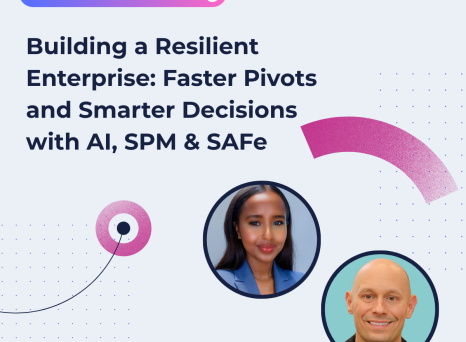This is the third installment in our series revisiting some of the key messages from our recent webinar on “How Agile PMOs can support Financial Planning“. Read the first article on the Role of the PMO: Help bridge the Agile expectations gap here, and the second on The State of Enterprise Agile here.
With the mainstreaming of Agile, Project and Portfolio Management Offices have had to learn to adapt. The critical roles & functions of the PMO are changing from one focused on delivering projects (if possible, on-time and on-budget) to facilitating the overall planning process of the entire product portfolio. From being a Project Management Office, the PMO is increasingly become a Portfolio Management Office.
But to be able to perform these roles, the PMO itself must change. As Margo Visitacion, Vice president and principal analyst with Forrester, one of the leading analyst IT advisory first, explains in this clip.
Transcript below
(Lightly redacted for clarity)
The structure of the PMO is changing
The structure of the PMO and planning in digital organizations is changing.
Traditional PMOs, it wasn't unusual for them to be quite large, have project managers reporting into them and be more focused on delivery.
In an Agile world, the PMO takes on a different role. It acts as a Portfolio Management Office versus a Project Management and delivery Office. So, it focuses more on helping an organization develop the framework, cadence, and guidance around the end-to-end planning process. It facilitates that planning process.
The planning offices that we see today and the, you know, “your label will vary”: we've seen everything from Strategic Planning Offices to Portfolio Centers of Excellence to Value Management Offices. What you call the organization doesn't really matter. It's how you put that end-to-end facilitation and planning guidance into place.
The Agile PMO in a Digital Organization
So, what we see now in PMOs is that the organization now becomes a combination of a virtual planning organization, that provides guidance to delivery teams. Very often the leader of this organization might be a chief product officer or a chief strategy officer. And again they're developing the framework and the cadence, so the strategic planning framework, the strategic product planning framework, the team and the PMO specifically then provide guidance.
Within that virtual planning organization, we're seeing the Agile PMO help bring together the right people to be involved in planning activities. So, they bring together architecture, enterprise architecture or various architecture representatives. They're bringing together the business owners that may own strategic themes and finance obviously must be at the table to help make decisions around planning and funding allocations.
The Agile PMO works as peers with Product Owners, Release Train Engineers and Value Stream Engineers that are making the decision around what's going to be funded at a high level, and providing the guidance to the [Product] Owners, and the Release Train Engineers about the allocation bucket that then drives prioritization guidance to delivery teams, that are going to prioritize the actual product backlog.
So, the Agile PMO in a digital organization is one that is a facilitating organization. They bring the expertise on the planning side. The delivery team support the decision-makers, execute the Release Trains and provide feedback on the performance at the portfolio level.
The PMO facilitates holistic planning and decentralized execution
By having this holistic planning, the PMO stops being the bottleneck from making the decisions around what projects are being prioritized because in a product focused world, the Product teams own that and they're the ones that oversee that. They're maintaining stakeholder alignment with their customers to determine what is the most valuable set of features we need to deliver what's gonna bring the best value back to the company through the delivery of said features. So, they're managing the product backlog. They're working with the executives to identify what is going to be most important from a revenue generation perspective.
The PMO comes into play in helping to facilitate the portfolio. They're focusing on dependency management. So, they're looking at the portfolio as the communication and the manifestation of the strategic product plan. And they're working with the EPIC teams and DevOps to identify where there are potential dependencies in work streams or investment streams at the portfolio level.
Agile PMOs help manage dependencies
One of the ways that Agile PMOs help manage these dependencies is through resource management. As Matt and I talked about earlier, resource capacity management doesn't go away in an Agile organization. Agile PMOs help to manage dependencies at the resource level by looking at the portfolio at its entirety, identifying multiple work streams, and then identifying potential resource constraints, because even if you have an unlimited resource budget or people budget, you are still going to have resource constraints.
So, a typical example that we see, especially in a shared services organization, is that those services and those resources that have to be shared, for example, in DevOps or architecture, certain types of security development or information security types of activities or information architecture. They tend to be shared resources. Agile coaches tend to be shared resources.
PMOs will support Scrum teams and planning teams by identifying potential resources, and then work with those individual product teams to sequence work streams, so that when you have to use a borrowed resource, that resource will be allocated to that sprint team for the entirety of that sprint. So, they're not being pulled off and juggling allocations between sprint teams or concurrent allocations between sprint teams.
As we can see, the introduction of new roles into the traditional PMO is needed to help facilitate planning activities, from architecture experts, to business owners for strategic direction, to finance for funding.
This group of strategic directors are now providing the planning process, for execution and feedback by the rest of the delivery team. This results in the evolved PMO also being an essential support to the organization in terms of resource management dependencies, as it has visibility of the portfolio (and its restraints) in its entirety.


